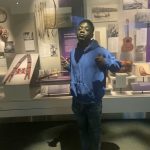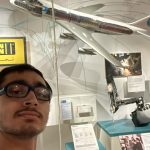By Professor Tiffany Banks On Tuesday, September 30th , students from my COMM 108: Foundations…
by Professor Katherine Smith, English

On Sunday afternoon of October 29, my English 101/011 class met up at the Museum of American History. After talking about and planning this museum visit with students since the beginning of the semester, it was exciting to be out of the classroom and experiencing the museum exhibits in real life. Outside the busy entrance of the museum on Constitution Avenue, a few participants from the Marine Corps Marathon that had taken place earlier that morning, their race numbers crumpled beside them, chatted about the race and drank energy drinks. At 12:30, tourists crowded the food trucks at the curb beneath a sky that threatened more rain after earlier morning showers.
Inside the museum, twenty or so students chatted cheerfully beside the “Dave’s Dream” low rider exhibit which is a popular gathering place. With its vivid yellow body splashed with brilliant colors and sparkling chrome fittings, the low rider is hard for students to miss (though a couple of students did and caught up with the class at the Greensboro lunch counter on the second floor). Some students were still wiping sleep from their eyes as they handed me their photo release forms. They introduced me to the parents, siblings, and friends they had brought along.
We had already done the “See, Think, Wonder” exercise for “Dave’s Dream” in class. We paused briefly to wonder at the “real” car before us and then the group headed upstairs. The students’ awe at “real life” was a continual theme throughout the afternoon. We stopped at the “Greensboro Lunch Counter” to pay our respects. Several students familiar with the events of February 1st told the story of the Greensboro Four, sit-ins, and their place in Civil Rights history. The students were awed to see the counter and chairs where so much history had taken place.
We then walked to the lobby for a group photo in front of the statue of George Washington. Students initiated their own “See, Think, Wonder” exercise, noting intricate details of the statue such as the snake figure on the pedestal and the finger pointing upward. Asked what they thought about when they saw the statue, this diverse group of community college students answered spontaneously and in unison, “Freedom.”
With scavenger hunt instructions in hand—as well as the assignment to find and photograph three objects they connected with—students set off to explore the “Many Voices, One Nation” exhibit, followed by “Democracy: The Great Leap of Faith.” Students periodically checked in with me to ask the whereabouts of assorted items. These check-ins lead to some memorable conversations. One such discussion took place in front of Lincoln’s inkwell. Students marveled that this object had held the ink with which the president had signed the Emancipation proclamation. Several students who had visited the Ford Theater reconstructed the day of Lincoln’s death. Beside the inkwell was the “Great Historical Clock of America” with its intricately carved gilded scenes of American history. In another case, among voting memorabilia, an oilcloth dog raincoat urging citizens to vote delighted the students.
Later, students fanned out to explore the Molina Gallery, where the “Tree of Life” captivated them. Other students went upstairs to the “Entertainment Nation” exhibit where they were entranced by Selena’s leather jacket, and Dorothy’s ruby slippers.
The students were by turns awed, amused, and enchanted to find “real” American history in the Museum of American History. Here are some of their responses in their own words:
“I had only been to the American History Museum once. But it wasn’t until I went back for my English class that I really got to do a deep dive and discover exhibits I hadn’t seen before. The one that really stuck with me was a Latino exhibit titled Presente! A Latino History of the United States. In this exhibit, I got to see many different objects and creations made by Latinos for Latinos. I was amazed at the beauty of it. One of these objects was a tree of life titled Raíces, historia, y justicia latinas. I was captivated by its uniqueness and artistry. It was in a case and was about 3 to 4 feet tall with a rotating stand so you could see a 360 view of this art piece. This piece of art really stuck with me. Raíces, historia, y justicia latinas has allowed me to see within my Latino culture and the diversity of it.”
”I had always believed that Dorothy’s ruby red slippers were a myth, an object that I would only see on the screen of a television. So, imagine my surprise when my college English professor announced that we would be meeting up at the Smithsonian Museum to find an object we would be relating to. There with the loud sounds of movies and actors of our most common entertainment industries, on the third floor introducing the art of moviemaking, is where Dorothy’s Ruby slippers are displayed for visitors to see. For the first time in a long time, I was astonished at the sight of finding a mythic object that I once thought was a rumor. My excitement was unmatched to any other object within the exhibit. Dorothy’s slippers were a huge part of my childhood as a Vietnamese immigrant descendent to America, my only way of truly adopting to America was by watching “the Wizard of Oz” over a hundred times on my dc tape. I highly related to Dorothy and even went out of my way to dress like her when I was little. This museum object Dorothy’s Ruby Slippers helped me understand my culture and identity as a Vietnamese immigrant descendent. As I observed this object in the Smithsonian Museum, I began to reminisce on the times where me and my family struggled growing up as Vietnamese immigrants in America.This object helped me understand my culture and identity as a Vietnamese immigrant descendent were by how I grew up as an outspoken Vietnamese descendent, being able to recognize the challenges of my grandparents, and how my parents and grandparent were separated by war.”
“Has any museum made you realize or understand your life better? Many museums can leave people feeling happy or inspired, but the Museum of American history can fill a person with knowledge about our country that can lead you see it from a unique perspective. The museum object, the “A Students Desk” from the “Many Voices One Nation” exhibit at the American Museum of history helped me understand my identity through what was taught in life.”
“The visit to the museum affected my understanding of the past because there were many facts that I never knew about or knew that they had artifacts that pertained to those events. It will affect the understanding of my future because when people talk about it, I will not be uninformed. If there is one thing, I would tell my future grandchildren about my museum trip it is that at first, I was bored because I had to go on a Sunday morning, but I would never regret it because I saw so many things and learned so many things about my Latin American history. If anything, I am glad I woke up early that Sunday morning to go on the museum trip.”
“I went through “Many voices One nation” exhibit multiple times between the other exhibit since it was our main project exhibit. Finally, I saw something remarkably familiar to me and my culture in it. It turned out that this exhibition had something that touched my heart which was ‘La Esperanza Bakery’ sign composed of green, red, and white. This semi-rectangular sign is horizontally divided into 3 equal sections which helped me understand my culture based on my family origin.”






This Post Has 0 Comments